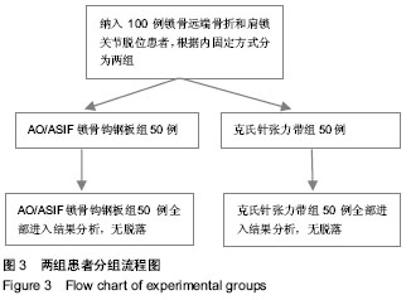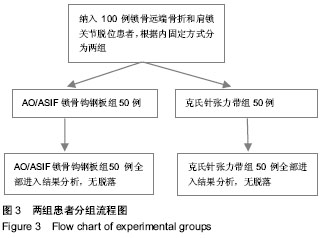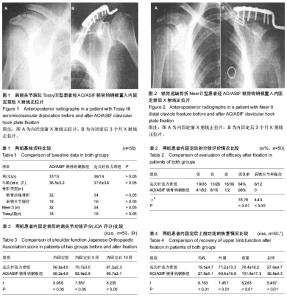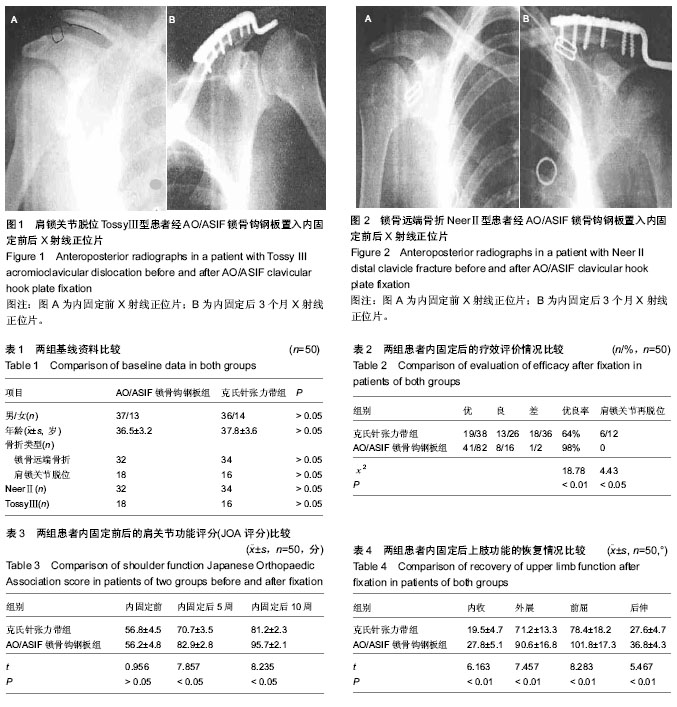| [1] 陈学海. 锁骨钩钢板治疗锁骨远端骨折和肩锁关节脱位28例分析[J].甘肃科技,2009,23(11):135-136.
[2] 王云华.锁骨钩钢板治疗锁骨远端骨折和肩锁关节脱位的临床观察[J]. 中国现代手术学杂志,2010,10(2):135-137.
[3] 汪正节. 锁骨钩钢板治疗锁骨远端骨折和肩锁关节脱位120例[J]. 第三军医大学学报,2010,15(18):2036-2037.
[4] 吴生平,范国志,邓先堂. 锁骨钩钢板治疗锁骨远端骨折和肩锁关节脱位60例[J]. 重庆医学,2010,21(18):2500-2501.
[5] 唐秀锦. 锁骨钩钢板治疗锁骨远端骨折和肩锁关节脱位的疗效观察[J].中国医药指南,2012,28(22):205-206.
[6] 詹远平.锁骨钩钢板治疗锁骨远端骨折和肩锁关节脱位18例疗效观察[J].中国医药指南,2013,14(7):550-551.
[7] 郑继会,苑娜,胡思斌. 锁骨钩钢板治疗锁骨远端骨折和肩锁关节脱位[J].创伤外科杂志,2011,7(1):40-42.
[8] 罗发军. 锁骨钩钢板治疗锁骨远端骨折和肩锁关节脱位[J]. 广西医学,2007,15(9):1361-1362.
[9] Muramatsu K, Shigetomi M, Matsunaga T, et al. Use of theAO hook-plate for treatment of unstable fractures of the distal clavicle. Arch Orthop Trauma Surg. 2007;127(3): 191-194.
[10] 潘淳,刘立明.锁骨钩钢板治疗锁骨远端骨折和肩锁关节脱位[J]. 临床骨科杂志,2008,9(4):351-352.
[11] 邹建平.锁骨钩钢板治疗肩锁关节脱位和锁骨远端骨折的临床疗效分析[D].广西医科大学,2009.
[12] 胡振伟. AO锁骨钩钢板与克氏针张力带钢丝治疗锁骨远端骨折的疗效分析[D].大连医科大学,2012.
[13] 黄家基,蒙家辉,施伟业,等.早期功能锻炼对锁骨远端骨折肩锁关节脱位术后疗效的影响[J]. 中国骨与关节损伤杂志,2010, 25(11):1022-1023.
[14] 潘子加,刘富光,赵加联,等.改良锁骨钩钢板在过度加压方面的处理[J].实用骨科杂志,2011,17(11):1050-1051.
[15] 郭秀全,杨丙秀.锁骨钩钢板治疗肩锁关节脱位并发症分析[J].中国骨与关节损伤杂志,2010,25(11):1046.
[16] 周勇,冉学军,邓长青,等.锁骨钩钢板内固定术后肩部疼痛和外展受限的分析[J].临床骨科杂志,2011,14(5):539-540.
[17] 姜利军,汪剑华,姜林峰.肩锁钩钢板与克氏针张力带固定治疗锁骨远端骨折脱位的疗效评价[J]. 江浙创伤外科,2011,16(3): 352-353.
[18] Flinkkila T, Ristiniemi J, Lakovaara M. Hook-plate fixation of unstable lateral clavicle fractures:a report on 63patients. Acta Orthop. 2006;77(4):644-649.
[19] Meda PV, Machani B, Sinopidis C, et al.Clavicular hook plate for lateral end fractures:a prospective study. Injury. 2009;37(3):277-283.
[20] Kashii M, Inui H,Yamamoto K.Surgical treatment of distal clavicle fractures using the clavicular hook plate. Clin Orthop Relat Res. 2010;(447):158-164.
[21] 谢世华,李霞,韩春鸣,等.锁骨骨折三种治疗固定方法的疗效比较[J] .临床医学工程,2011,21(2):211-212.
[22] 冯永增,洪建军,陈鸿亮,等.锁骨钩钢板与 Endobutton 钢板治疗肩锁关节脱位的对比研究[J].中华骨科杂志,2009,11(11): 1009-1014.
[23] 刘宇军.锁骨钩钢板治疗锁骨远端骨折和肩锁关节脱位发生并发症的原因分析[J]. 实用医学杂志,2012,22(3):457-458.
[24] Meda PV, Machani B, Sinopidis C, et al. Clavicular hook plate for lateral end fractures:a prospective study. Injury. 2008; 37(3): 277-283.
[25] Kashii M,Inui H,Yamamoto K. Surgical treatment of distal clavicle fractures using the clavicular hook plate. Clin Orthop Relat Res. 2009;(447):158-164.
[26] Mc Cormebl AJ, Yoc DJ, Zedro R,et al.Methods of opprative fixation of the aeromio- clavicular joint:a biomechenical comparison. J Orthop Trauma. 2010;21(4):248-253.
[27] 王凯,王申涛.锁骨钩钢板治疗锁骨远端骨折和肩锁关节脱位的体会[J]. 现代医药卫生,2010,27(12):1774-1776.
[28] 王庆刚,郭雄虎. AO锁骨钩钢板治疗锁骨远端骨折和肩锁关节脱位32例疗效观察[J]. 中国社区医师(医学专业),2010, 42(19): 109.
[29] 陈陆平,蔡学海,陈韬,等.锁骨钩钢板治疗锁骨远端骨折和肩锁关节脱位[J].中国基层医药,2004,24(5):34-35.
[30] 王秀士,孙建,李大伟. 锁骨钩钢板治疗锁骨远端骨折和肩锁关节脱位52例疗效分析[J]. 医学信息(上旬刊),2011,18(7): 4579-4580.
[31] 胡振伟. AO锁骨钩钢板与克氏针张力带钢丝治疗锁骨远端骨折的疗效分析[D].大连医科大学,2012.
[32] 李浩,易疆莺,曹万军,等. AO锁骨钩钢板治疗锁骨远端骨折和肩锁关节脱位[J].中国骨与关节损伤杂志,2007,34(12):1012- 1013.
[33] 郑建平,田琴. AO/ASIF锁骨钩钢板治疗肩锁关节脱位及锁骨远端骨折[J]. 临床骨科杂志,2009,3(3):348. |



